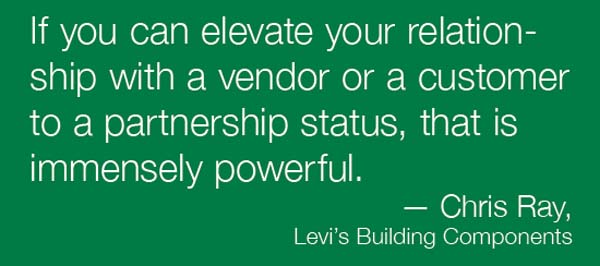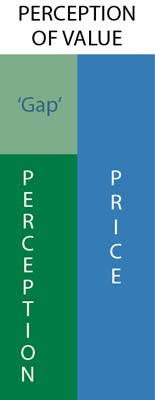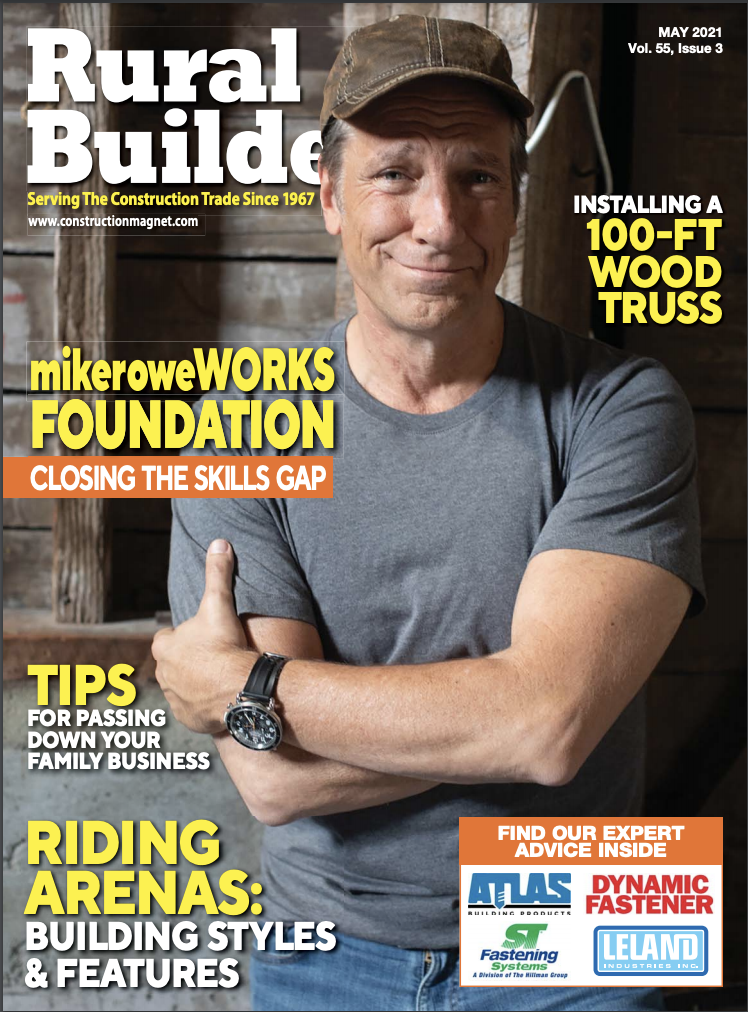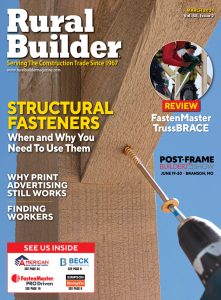Chris Ray, National Sales Manager at Levi’s Building Components, presented “Sell More — Better” at the Construction Rollforming Show on December 12 in Cincinnati, Ohio. The engaging and insightful talk taught attendees how salespeople could connect with potential customers in such a way as to be more likely to begin a more successful buyer-seller relationship.
The first step for a more successful selling experience is to learn to think differently about selling. Ray said, “Selling has come to be a sort of dirty word,” and that some people look at it as a thing we have to do to survive.
Sometimes we need to look at sales differently. “We can consider different ways to approach a sale for a better outcome,” he said.
Building Long-Term Customer Relationships
In part, company success is built on long-term customer relationships. Anybody can earn a customer one time. You can buy a customer with a really low price, but creating a long-term relationship is where the real value lies because long-term customers are the foundation for your business, he explained. Those customers become your advocates. They’ll speak well of you to others.
Ray said in his experience, you have to earn somebody’s trust every day. It’s not something you do once and then you’re done. You get them as a customer or a friend or whatever the situation happens to be, and then you have to support that relationship. “It’s like your car, or horse, or machine — you have to keep putting energy into it to get production out of it,” he said.
One of the keys to building relationships is that you have to reaffirm to your customer every day that they’ve made the right choice by choosing you. They become the building blocks of your growth. The foundation of business is often built with things within the company and outside of the company. Within the company it is the people, products, and systems that are in place. Outside the company, your foundation is strengthened by the customers, and from your foundation you can grow.
Your customers also become an important component of your marketing. Third-party endorsements, Ray said, are the most powerful thing when it comes to what your image is out in the sector. People expect you to be able to speak well about why your company is the best choice for them. They expect you to be able to tell them why they should choose to buy their products from you, why they should choose to deal with or build a building with you, he explained. “In fact, if you can’t do that, you better go back to square one and figure out what you’re doing.”
“What’s unexpected,” Ray continued, “and much more powerful, is when someone else — without you prodding them or asking them — endorses you. That’s a third-party opinion that speaks only of their experience with you. That experience is composed of the interaction they have with you personally, the interaction they have with your company. The sharing of their positive experience speaks highly of your company. Do that consistently. Build those relationships every opportunity you get to create this endorsement. This endorsement is more valuable than any ad you can buy or social media post you can make, Ray said.
Building trust in a relationship is very important. If you can elevate your relationship with a vendor or a customer to a partnership status, that is immensely powerful. If they have a problem and you’ve developed a partnership with them over time, they’ll come to you first to solve that problem before they do something drastic (like leave. Your customers need to be comfortable enough with you to approach you.
Problems can be a good thing, he said in the presentation. Not that you want to go out and try to create one, but a problem is another opportunity for you to show your customer why they picked you in the first place. “How you handle a problem is huge. It touches everything. It touches the long-term relationship, the partnership status.” It reaffirms they made the right choice by choosing you; it makes them tell themselves, “You know what, I made the right choice.” Once you have that partnership, that growing relationship, you’ll keep growing and be there with them.
You’ll find that the time and effort you spend on a customer is not a cost, it’s an investment. The definition of an investment is something that returns something greater than itself.
How to Read People
Don’t forget that people buy from people. Any company is not brick-and-mortar, Ray emphasized. It’s not even the products. “Your company is its people. If you’re a one-man operation, you’re the company. You’re the people. People do business with people.”
Don’t ever think that numbers drive everything, Ray cautioned. A person is not going to buy your product if they don’t feel they can trust you or if they don’t have a good relationship with you. The first step to building that relationship is connecting through effective communication.
“Communication style is a window into the personality of an individual,” he said. “How someone talks to you will tell you much about themselves.” You can tell within a few sentences what type of personality they have.
One way of labeling personality types is by color. Ray said if you can identify their personality type, you can identify how to best connect in your conversation, which can result in a more positive outcome for both parties.
Ray and others before him have broken down communication types into four basic categories or sectors, labeling them with colors and likening them to birds. He then identified how you might connect with that person in their own type of language, and then transition the conversation to where you want it to go. Ultimately, you want to do two things: You want to determine the type of personality you’re speaking with, and then, from a “blue” perspective, transition the conversation into something constructive.

For example, people who have a “blue” personality (the owl) are thinkers. They like to analyze and break things down. Ray explained, “It’s a person who you ask for a piece of information and they hand you a big, long spreadsheet.” Blue personalities need goals, details, and timelines. They’re purpose-driven, have expectations, and expect results. They are often controllers and project managers. They require all the facts to make decisions.
When trying to take control of the direction of the conversation, you might say something like, “I can see you put a lot of work into the details. Thank you for that. May I ask you a question?” and then ask a question relevant to the discussion, perhaps clarifying a point. Then compliment them. Tell them, “Okay, thanks for that … Can I talk with you about two things for you to consider as well?” This steers the conversation into the direction that you want it to go, so you can get to the point where you can get a transaction to take place.
“Green” (dove) personality types are doers who follow. They are often the people on teams who do the thinking and creation. They want harmony; they have patience, empathy, and compassion. “If somebody’s having a tough time with something, a green personality wants to fix it,” Ray explained in the presentation.
To connect with a green personality, you might say, “Thank you, I sincerely appreciate that. Incidentally, can I ask you to help me with something?” This allows for you to connect with them and it directs the discussion to a place where decisions can be made.
“Red” personalities (eagles) are aggressive, assertive, and competitive. They are leaders; many times CEOs have some portion of a red personality. If they’re in a group of people talking about how to handle something, they take charge and go. They are “let’s get it done” sort of people who like to dictate and may dominate the conversation.
To connect with someone who has a red, take-charge type of communication style, you can’t talk to them with a green, more timid communication style; the two won’t connect. If you determine that you’re talking with a person who has a red communication style, come more close to their language. You might say (speaking a bit louder and stronger), “Yeah, that’s great. I can really appreciate that. If I can take a second, let me back up and cover a couple of points.” Then you’re going to connect with that person and can then move the discussion into the blue, thinker area, because it’s in the blue sector that decisions are made more often than anywhere else.
People with “yellow” communication styles (peacock) have bright personalities. They have big personalities who own a conversation. They’re probably the easiest to pick out because they’re all pumped up and coming at you, Ray said. They use volume and take charge of conversations.
To connect with a “yellow,” you have to be a bit loud and use an excited tone, and then you can tone it down and try to take that conversation to a place where you can talk about business. “Wow. This is amazing! By the way, can I share a couple of things with you.” You want to take that conversation to an area where you can actually talk about business.
In all these scenarios, identifying the type of personality and directing the conversation will help you to get a transaction to take place. They allow you to talk to the customer and create something of value to both of you: a sale.
Building The Perception Of Value
Perception is reality. It doesn’t matter whether it’s right or not; it’s true. A person’s perception is their reality, Ray explained. So if you don’t speak to that person’s perception, and only stay in the facts, you’re going to miss a vital part of communication.
If the customer’s perception is that you’re too expensive, they don’t perceive the value at the same level that you do. Their objection is a great opportunity because how you handle this is everything. If you respond to their objection with a price response, Ray explained, you’ve missed a great opportunity and it’s likely you’ll have to lower your price further because you haven’t focused on the perception of value.
If someone says it’s too much, the first thing you should do is tell them, “Thank you for letting me know that,” Ray advised. They’re giving you the opportunity to respond. That’s what they’re looking for. The alternative is they turn and walk away and the opportunity is gone.
Time is valuable, and here’s how time fits into making more sales: Any time you want to spend somebody’s time, or make them spend time, ask permission, he advised. Be realistic about the amount of time you are asking for. Say something like: “If you have a minute, maybe two, I just want to revisit the product a little bit and tell you about it so we have a clear understanding of the product.” It lets you go back and build the perception of value.

One of the reasons somebody feels products are too expensive is they’re not comparing apples to apples; they’re comparing apples to oranges. Chances are there’s something about your product that potential customer doesn’t know or something that they hadn’t focused on. In teaching them and telling them, you’ll grow their perception of value. When we fill in that gap between perception of value and price, price becomes less important because their perception of the value of whatever they’re buying from you is worth it; you reduce their objection based on price.
People, Quality, Service
& The Role They Play In Your Success
Once again, companies are composed of people. People buy from people. People interact with people. We drive everything; we are our companies; we are our relationships.
Is quality just products or is it more than that? More often than not we think of quality as the quality of the product. Quality can be a whole different number of other things. Quality can be construed as service (i.e. quick shipping; prompt responses to questions), too. How those indications go help define quality. Serve people well and you’ll sell well.
We work for our customers, Ray said. Our customers are the people that we are working for, so listen to them. Value their input. Serve them. Having a servant way of operating is a very, very powerful thing. That’s what inspires your customers to give you endorsements and that’s where new opportunities come from.
As an added bonus, in doing things the right way, you become a great place to work. When you become or keep being a really good place to work, it positions you to help overcome the labor shortage.
It’s not all just benefits. Oftentimes it’s systems, processes, interactions that people who work there have, and how you handle issues internally.
The Power Of Observation
In small businesses, oftentimes the owner of the company is also placing orders, selling, making things, managing, dealing with the insurance company, they’re doing everything in the company that needs to be done. Sometimes the worst way to see how things are going in your business is when you’re right in the middle of it. You can only see out; you don’t see in.
Where you want to get to is outside the business. If you can get yourself outside of your business, even for a short time, you can see things you didn’t expect to see. Observe what’s going on. Remove yourself; then you’re taking the position your customers are seeing every day. It’s really important to get outside your business. Even small businesses with only a couple of employees need to do this kind of thing. If you don’t know what your customers are seeing — their perspective — how can you operate the right way?
Success By Accident
Some companies have had varying degrees of success in the last couple of years. Some companies may be mildly up and some are way up. It’s great to feel good about accomplishments. But if you don’t know how you got there, you can’t repeat it. It’s a great thing to applaud, but you don’t want to keep applauding it. If you’re up 30% this year, ask yourself why. Success by accident cannot be repeated. You need to know how you got where you are. Did you add people in the shop? Did you change materials? Did you add new products? What are the things that contributed to your success? Knowing how you got there allows you to build on your success.
In short, honing your one-on-one communication skills and ability to objectively observe and adjust your business practices can give you a jump on building your business.




















